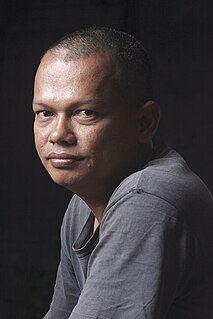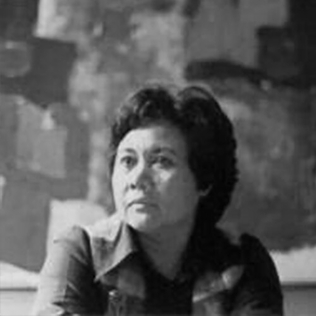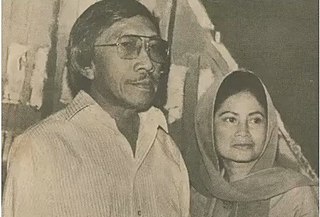Related Research Articles

The Staatliches Bauhaus, commonly known as the Bauhaus, was a German art school operational from 1919 to 1933 that combined crafts and the fine arts. The school became famous for its approach to design, which attempted to unify the principles of mass production with individual artistic vision and strove to combine aesthetics with everyday function.

The history of painting reaches back in time to artifacts and artwork created by pre-historic artists, and spans all cultures. It represents a continuous, though periodically disrupted, tradition from Antiquity. Across cultures, continents, and millennia, the history of painting consists of an ongoing river of creativity that continues into the 21st century. Until the early 20th century it relied primarily on representational, religious and classical motifs, after which time more purely abstract and conceptual approaches gained favor.

Op art, short for optical art, is a style of visual art that uses optical illusions.

Chinese painting is one of the oldest continuous artistic traditions in the world. Painting in the traditional style is known today in Chinese as guó huà, meaning "national painting" or "native painting", as opposed to Western styles of art which became popular in China in the 20th century. It is also called danqing. Traditional painting involves essentially the same techniques as calligraphy and is done with a brush dipped in black ink or coloured pigments; oils are not used. As with calligraphy, the most popular materials on which paintings are made are paper and silk. The finished work can be mounted on scrolls, such as hanging scrolls or handscrolls. Traditional painting can also be done on album sheets, walls, lacquerware, folding screens, and other media.

Theo van Doesburg was a Dutch artist, who practiced painting, writing, poetry and architecture. He is best known as the founder and leader of De Stijl. He was married to artist, pianist and choreographer Nelly van Doesburg.

Kamāl ud-Dīn Behzād, also known as Kamal al-din Bihzad or Kamaleddin Behzād, was a Persian painter and head of the royal ateliers in Herat and Tabriz during the late Timurid and early Safavid Persian periods. He is regarded as marking the highpoint of the great tradition of Islamic miniature painting. He was very prominent in his role as a director of a workshop in the Herat Academy as well as his position in the Royal Library in the city of Herat. His art is unique in that it includes the common geometric attributes of Persian painting, while also inserting his own style, such as vast empty spaces to which the subject of the painting dances around. His art includes masterful use of value and individuality of character, with one of his most famous pieces being "The Seduction of Yusuf”' from Sa'di's Bustan of 1488. Behzād’s fame and renown in his lifetime inspired many during, and after, his life to copy his style and works due to the wide praise they received. Due to the great number of copies and difficulty with tracing origin of works, there is a large amount of contemporary work into proper attribution.
Ashley Bickerton is a contemporary artist. A mixed-media artist, Bickerton often combines photographic and painterly elements with industrial and found object assemblages. He is associated with the early 1980s art movement Neo-Geo.

Croatian art of the 20th century, that is visual arts within the boundaries of today's Croatia, can be divided into modern art up to the Second World War, and contemporary art afterwards.
I Nyoman Masriadi is a painter and a leading artist of the post-Suharto era in Indonesia. His works have gained a collectors base which includes prominent collectors in and around the region.

Michelangelo Pistoletto is an Italian painter, action and object artist, and art theorist. Pistoletto is acknowledged as one of the main representatives of the Italian Arte Povera. His work mainly deals with the subject matter of reflection and the unification of art and everyday life in terms of a Gesamtkunstwerk.
Taring Padi is a collective of underground artists in Yogyakarta, Indonesia. The group was formed in 1998 during the general upheaval following the fall of Suharto.

Thomas Lawson is an artist, writer, magazine editor, and Dean of the School of Art at California Institute for the Arts. He emerged as a central figure in ideological debates at the turn of the 1980s about the viability of painting through critical essays, such as "Last Exit: Painting" (1981), and as one of the artists in the loosely defined "Pictures Generation" group. He has been described as "an embedded correspondent [and] polemical editorialist" who articulated an oppositional, progressive position for representational painting from within an increasingly reactionary art and media environment. Artforum called his approach to the medium "one of the most cogent and controversial" in the 80s.
Nicola Verlato is an Italian painter, sculptor, architect and musician based in Los Angeles, California.

Yunizar is an Indonesian artist. He was born in Talawi, West Sumatra, Indonesia. He graduated in 1999 with a degree in Fine Arts from Indonesian Institute of the Arts, Yogyakarta (ISI), a school of national pride and the heart of progressive art-making in Indonesia. Creativity and change are the forefront of the school's agenda and this is evident in Yunizar's work ethic. Yunizar's training reveals itself in his sophisticated expressive style, articulated through a playful composition and subtle palette. Executed primarily in acrylic and pencil, his works stand out in terms of texture, colour, brushwork and rhythm. A restrained palette of cool colours- yellows, browns and greens- is deliberately dirtied and smudged in his working and reworking of the canvas. The result is a highly tactile work that entices the viewer to feel the piece.
Arte Informale is a term coined in 1950 by the French critic Michel Tapié to refer to the art movement that began during the mid-1940s in post-World War II Europe. This movement also paralleled the Abstract Expressionism movement that was taking place at the same time in the United States, and had ties to the Arte Povera movement. Sometimes referred to as Tachism, Art Autre or Lyrical Abstraction, it was a type of abstraction in which form became less important than that of the expressive impulses of the artist, and was opposed to the rationalism of traditional abstraction. The qualities of informal art explore the possibilities of gesture, materials, and signage as the basis of communication. Oftentimes art characterized as informal is executed spontaneously and the approach to painting and sculpture are generally gestural, performative, expressionistic and experimental. Certain artists such as Lucio Fontana, Alberto Burri and Emilio Vedova were crucial figures of this movement.

Blenheim Art Foundation (BAF) is a multi-award-winning non-profit organisation that presents large-scale contemporary art exhibitions at Blenheim Palace.

Indonesian painting has a very long tradition and history in Indonesian art, though because of the climatic conditions very few early examples survive, Indonesia is home to some of the oldest paintings in the world. The earliest Indonesian paintings were the rock paintings of prehistoric times, such as the petroglyphs found in places like in the caves in the district of Maros in Sulawesi, Indonesia. The Stone Age rock paintings found in Maros Cave are approximately 40,000 years old and are listed as one of the oldest paintings in the world.

Umi Dachlan, born Umajah Dachlan,, was a pioneering Indonesian painter and an art lecturer. She graduated from the Faculty of Fine Arts and Design at the Bandung Institute of Technology ITB in 1968 as the third female graduate, where she also become the first female lecturer. Her work has been described as Abstract expressionism with a figurative Lyricism.

Kanjeng Raden Haryo Tumenggung H. Srihadi Soedarsono Adhikoesoemo was an Indonesian painter and tenured lecturer. He married Farida Srihadi, who is also an accomplished painter that studied at the Bandung Institute of Technology (ITB), as well as abroad in the Netherlands and England.

Ahmad Sadali comes from a family with diversified batik and printing businesses. He was an Indonesian painter and art lecturer who is well-known for his abstract art, especially Abstract expressionism, and Cubism and Color field painting. Sadali was among the first and leading students of Ries Mulder, that represented "The Bandung School" of Indonesian art. He is considered one of the most important Indonesian modernist artists, and his works are among the highest priced Indonesian in International art markets. His signature Abstract style expresses elements of nature and spirituality in a bold yet nuanced manner.
References
- ↑ "FENDRY EKEL: Witness". Archived from the original on 2009-05-09. Retrieved 2009-10-10.
- ↑ "Lower Manhattan Cultural Council - News - Story - Indonesian Contemporary Art Exhibition in the Lower East Side". Archived from the original on 2014-01-09. Retrieved 2014-01-09.
- ↑ "Arndt - Fendry Ekel".
- ↑ "THE SULTANS OF INDONESIAN ART - Article detail - Flash Art". Archived from the original on 2014-01-06. Retrieved 2014-01-06.